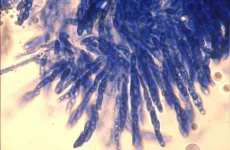(Press-News.org) Researchers have re-animated specimens of a fungus that causes coffee wilt to discover how the disease evolved and how its spread can be prevented.
Coffee Wilt Disease is caused by a fungus that has led to devastating outbreaks since the 1920s in sub-Saharan Africa, and currently affects two of Africa's most popular coffee varieties: Arabica and Robusta.
The new research shows that the fungus likely boosted its ability to infect coffee plants by acquiring genes from a closely related fungus, which causes wilt disease on a wide range of crops, including Panama disease in bananas.
The researchers say this knowledge could help farmers reduce the risk of new disease strains emerging, for example by not planting coffee together with other crops or by preventing the build-up of plant debris that could harbour the related fungus.
The research team, from Imperial College London, the University of Oxford, and the agricultural not-for-profit CABI, also say that studying historical samples in CABI's culture collection could provide a wealth of insights into how crop diseases evolve and find new, sustainable ways to fight them. The study is published today in BMC Genomics.
First author of the study Lily Peck is studying on the Science and Solutions for a Changing Planet Doctoral Training Partnership at the Grantham Institute and the Department of Life Sciences at Imperial. She said: "Using ever-higher volumes of chemicals and fungicides to fight emerging crop diseases is neither sustainable nor affordable for many growers.
"If we can instead understand how new types of diseases evolve, we can give growers the knowledge they need to reduce the risk of new diseases emerging in the first place."
The team re-animated cryogenically frozen samples of the fungus that causes Coffee Wilt Disease. There have been two serious outbreaks of the disease, in the 1920s-1950s and between the 1990s-2000s, and it still causes damage. For example, in 2011, 55,000 Robusta coffee trees were killed by wilt in Tanzania, destroying 160T of coffee in the process - equivalent to over 22 million cups of coffee.
In the outbreak beginning in the 1920s, Coffee Wilt Disease infected a wide range of coffee varieties, and was eventually brought under control in the 1950s by management practices such as burning infected trees, seeking natural resistance in coffee, and breeding programs that selected for more resistant plant varieties.
However, the disease re-emerged in the 1970s and spread extensively through the 1990s-2000s. Two separate disease populations have been identified with each only infecting specific types of coffee: one infecting Arabica coffee in Ethiopia, and the other infecting Robusta coffee in east and central Africa. The team wanted to investigate how the two strains had emerged.
In a secure lab at CABI, they re-awakened two strains from the original outbreak, collected in the 1950s and deposited into CABI's collection, and two strains each from the two coffee-specific fungal strains, with the most recent from 2003. They then sequenced the genomes of the fungi and examined their DNA for evidence of changes that could have helped them infect these specific coffee varieties.
They discovered the newer, variety-specific fungi have larger genomes than the earlier strains, and they identified genes that could have helped the fungi overcome plants' defences and survive within the plants to trigger disease.
These genes were also found to be highly similar to those found in a different, closely related fungus that affects over 120 different crops, including bananas in sub-Saharan Africa, causing Panama disease, which is currently devastating today's most popular variety, the Cavendish banana.
While strains of this banana-infecting fungus are known to be able to swap genes, conferring the ability to infect new varieties, the potential transfer of their genes to a different species of fungi has not been seen before. However, the team note that the two species sometimes live in close proximity on the roots of coffee and banana plants, and so it is possible that the coffee fungus gained these advantageous genes from its normally banana-based neighbour.
Coffee and bananas are often grown together, as coffee plants like the shade provided by the taller banana plants. The researchers say their study could suggest not growing crops with closely related diseases together, like banana and coffee, could reduce the possibility of new strains of coffee-killing fungi evolving.
The researchers are now using the re-animated strains to infect coffee plants in the lab, in order to study exactly how the fungus infects the plant, potentially providing other ways to prevent the disease taking hold.
The insights could also be applied to different crop plants, where other closely related plant pathogens could make similar leaps, causing new diseases to emerge. Having shown the value of examining historical specimens of plant disease, the team plan to replicate the study with other diseases stored in CABI's collection, which hosts 30,000 specimens collected from around the world over the past 100 years.
Lead researcher Professor Timothy Barraclough, from the Department of Zoology at Oxford and the Department of Life Sciences at Imperial, said: "The historical approach shows us what happens to a plant pathogen before and after a new outbreak of disease occurs. We can then study the mechanisms of evolution and improve predictions of how similar outbreaks could occur in the future.
"Our aim is to replicate this study for many plant pathogens, eventually drawing up a 'rule book' of how pathogenicity evolves, helping us to prevent future outbreaks where possible."
INFORMATION:
Sea ice in the coastal regions of the Arctic may be thinning up to twice as fast as previously thought, according to a new modelling study led by UCL researchers.
Sea ice thickness is inferred by measuring the height of the ice above the water, and this measurement is distorted by snow weighing the ice floe down. Scientists adjust for this using a map of snow depth in the Arctic that is decades out of date and does not account for climate change.
In the new study, published in the journal The Cryosphere, researchers swapped this map for the results of a new computer model designed to estimate snow depth as it varies year to year, and concluded that sea ice in key ...
Concerns about side effects and whether vaccines have been through enough testing are holding people back from getting vaccinated against COVID-19, according to a new report.
Data from an international survey of 15 countries* which ran between March and May this year showed that these were the most commonly cited reasons for not having had a coronavirus vaccine yet, in addition to not being eligible for one. Respondents' other commonly reported reasons included concerns about not getting the vaccine they would prefer, and worries over whether the vaccines are effective enough.
Led by Imperial College London's Institute of Global Health Innovation in collaboration with YouGov, the survey also looked at trust in COVID-19 vaccines. ...
A University of Birmingham-led study funded by the UK Coronavirus Immunology Consortium has found that many patients with COVID-19 produce immune responses against their body's own tissues or organs.
COVID-19 has been associated with a variety of unexpected symptoms, both at the time of infection and for many months afterwards. It is not fully understand what causes these symptoms, but one of the possibilities is that COVID-19 is triggering an autoimmune process where the immune system is misdirected to attack itself.
The study, published today (June 4) in the journal Clinical & Experimental Immunology, investigated the frequency and types of common ...
Under embargo until Thursday 3 June, 23:30 UK time / 18:30 US Eastern time
Peer-reviewed observational study in people
Prior Covid-19 infection reduces infection risk for up to 10 months
The risk of being infected with SARS-CoV-2, the virus that causes Covid-19, is substantially reduced for up to 10 months following a first infection, according to new findings from the Vivaldi study led by UCL researchers.
For the study, published in Lancet Healthy Longevity, researchers looked at rates of Covid-19 infections between October and February among more than 2,000 care home residents and staff, comparing those who had evidence of a previous infection up to 10 months earlier, as determined by antibody testing, with those who had ...
Levels of antibodies in the blood of vaccinated people that are able to recognise and fight the new SARS-CoV-2 Delta variant first discovered in India (B.1.617.2) are on average lower than those against previously circulating variants in the UK, according to new laboratory data from the Francis Crick Institute and the National Institute for Health Research (NIHR) UCLH Biomedical Research Centre, published today (Thursday) as a Research letter in The Lancet.
The results also show that levels of these antibodies are lower with increasing age and that levels decline over time, providing additional evidence in support of plans to deliver a vaccination boost to vulnerable people in the Autumn. ...
An immunotherapy drug given after surgery improved disease-free survival rates in patients with kidney cancer at high risk of relapse.
Interim results of a phase 3 trial of adjuvant therapy revealed a 32% decrease in the risk of recurrence or death with pembrolizumab compared with a placebo
This is the first positive study of immunotherapy in patients with kidney cancer at high risk of relapse.
BOSTON -- Treatment with an immunotherapy drug following kidney cancer surgery, prolonged disease-free survival rates in patients at high risk for recurrence, according to an interim ...
Sickle cell disease (SCD) is the most common deadly genetic disorder, affecting more than 300,000 newborns worldwide each year. It leads to chronic pain, organ failure, and early death in patients. A team led by researchers at the Broad Institute of MIT and Harvard and St. Jude Children's Research Hospital has now demonstrated a base editing approach that efficiently corrects the mutation underlying SCD in patient blood stem cells and in mice. This gene editing treatment rescued the disease symptoms in animal models, enabling the long-lasting production of healthy blood cells.
The root of SCD is two mutated copies of the hemoglobin gene, HBB, which cause red ...
After a 2020 Vanderbilt University Medical Center study showed women have a difficult time accessing treatment for opioid use disorder (OUD), investigators analyzed comments received from the study's participants to further shed light on barriers to care, which included everything from long on-hold times to difficult interactions with clinic receptionists during phone calls seeking appointments.
A "secret shopper" study published in JAMA Network Open in 2020 used trained actors trying to get into treatment for opioid use disorder in 10 U.S. states. More than 10,000 unique "patients" were randomly assigned to be pregnant or non-pregnant and have private or Medicaid-based insurance to assess differences ...
MEMPHIS, Tenn. - Cardiovascular imaging demonstrated no evidence of myocardial injury or myocarditis in athletes after COVID-19 infection, according to a research letter published in Circulation by Le Bonheur Children's Hospital and the University of Tennessee Health Science Center cardiologists. The screening and evaluation was conducted by the Le Bonheur Children's Heart Institute Sports Cardiology team, Benjamin S. Hendrickson, MD, Ranjit R. Philip, MD, and Ryan E. Stephens, NP-C, MBA, and Le Bonheur Director of Cardiac MRI Jason N. Johnson, MD, MHS. Researchers say this study confirms existing recommendations ...
The North American mockingbird is famous for its ability to imitate the song of other birds. But it doesn't just mimic its kindred species, it actually composes its own songs based on other birds' melodies. An interdisciplinary research team has now worked out how exactly the mockingbird constructs its imitations. The scientists determined that the birds follow similar musical rules as those found in human music, from Beethoven to Kendrick Lamar.
The song of the mockingbird is so complex that to investigate it required a joint effort of experts from very different fields. Neuroscientist Tina Roeske of the Max Planck Institute for Empirical Aesthetics, field biologist Dave Gammon of Elon University, ...




